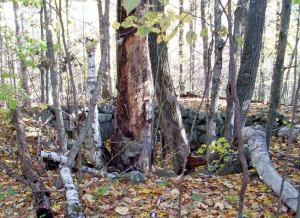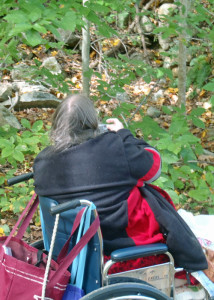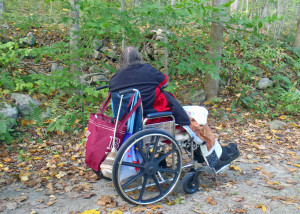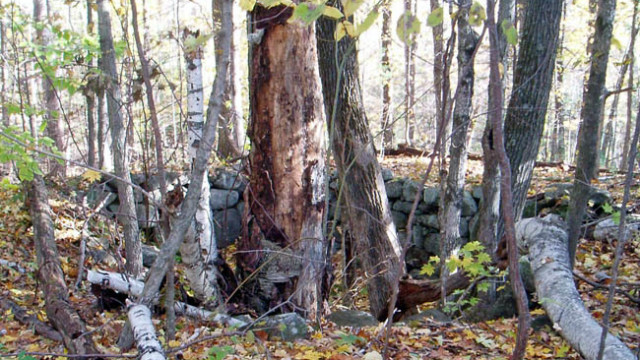
I love stone walls–perhaps because I grew up in a house where the longest side of our triangle-shaped lawn was bordered by a stone wall. My very first Active Outdoors adventures involved crossing that wall into “The Lane,” an old track that wandered off into a seemingly vast wilderness of woods crisscrossed with other stone walls and dotted with old cellarholes. Ghosts roamed there, it seemed. . . so did deer, rabbits, grouse, and my friends and I .
I was reminded of this the other day while walking along the Appalachian Trail in Connecticut with Peggy Knox on her first hike since she started using a wheel-chair for daily mobility. The section of trail we hiked had stone walls in the woods alongside and stone foundations for structures long since gone from both sight and memory. Peggy delighted in the stonework, wondering aloud when the stones were laid, to what purpose, and what the people, buildings and the landscape looked like at the time. Her delight rekindled my own love of touching the past.

Stone walls are a clear reminder of human history and the tremendous effort and determination of our forefathers to shape this land. I’ve heard it said that a rod (16.5 feet) of stone wall was a week’s work for two experienced men and a trained team of oxen. Calculate that times the thousands of miles of walls that still exist (some estimates say close to a quarter-million miles of walls once outlined New England’s fields, pastures and roads), and it’s an amazing number of man-and-animal hours.
When the walls were built (most between 1775 and 1850), the largest base stones were laid in a trench dug into the ground to minimize frost heaving. Then the walls were raise to the height a man could still easily lift the cap stones– about waist high or a little higher. The walls helped delineate property boundaries and contain wandering livestock. A couple of centuries of leaf litter and debris have built up around the stone walls you see today. Many are now probably deeper in the ground than they are high.
The next time you are hiking a woodland trail and it crosses a stone wall, turn and walk with the wall, to see where it takes you and what you find. Just be sure to keep track of the twists and turns you make so you can find your way back!

Try to imagine what the land looked like when it was all cleared pasture and farm fields. (Nobody ever built a stone wall though the woods!) Was this wall just a property boundary? If so, it might not be as high or as well made. Was it designed to keep sheep out of a kitchen garden? Those have probably lasted.
Follow stone walls far enough and you’ll often find the stone foundations of a barn and a house. Sometimes they are still standing, sometimes not. People were born there, lived there, died there. By getting out and walking the boundaries of their land, visiting their homesites, you’ve touched a part of their history with your own life.
This is a wonderful time of year to go looking for history. In the brief time when leaves are off the trees and snow has yet to cover the ground everything is exposed and visible. It’s that way again for a shining moment in the spring, as well, just before the leaves start to unfold. But if you postpone even a few days at either time of year, everything gets covered again and you’ll have missed your grand opportunity. Life isn’t a spectator sport. Get out, follow a stone wall, and enjoy!
Choose Your Adventure

Hiking through history is another of those active outdoor adventures which can be as large or as small, as easy or difficult as you wish to make it. Peggy did it in a wheelchair. You can explore close to home or far away, in the wilderness or in your backyard, on a short stroll or a long and challenging hike.
There are two basic approaches. One is to do a little library research, find something that interests you, then go seek it out. The other is to go somewhere, find something interesting and then puzzle out what it is you’ve found. Either way gives you a perfect excuse for getting out the door and having fun.
The history of the New England countryside is far too big and beautiful to be contained in any museum. You have to get out and search, exercise your eyes and mind, and put some miles under your boot soles to see even a tiny portion of it.
More Solid Info
If stone walls fascinate you, you might want to read “Stone By Stone” or “Exploring Stone Walls: A Field Guide to New England’s Stone Walls,” both by Robert Thorson. Another book worth getting is “Sermons in Stone: The Stone Walls of New England and New York” by Susan Allport.
There ares also two website on stonewalls. I found the one at www.primaryresearch.org/stonewalls to be absolutely fascinating (but I’m a stone wall geek). The other www.stonewall.uconn.edu/ covers mostly the Thorson material. Either, though, will help your understanding and enjoyment of these lovely remnants of our area’s past.


